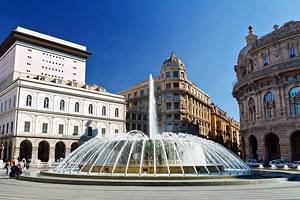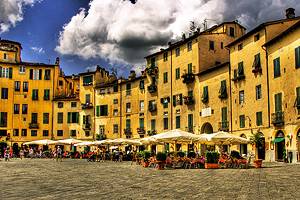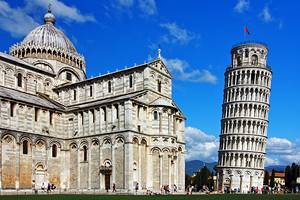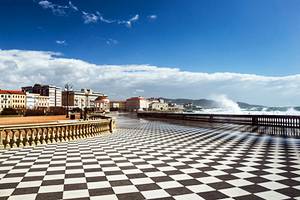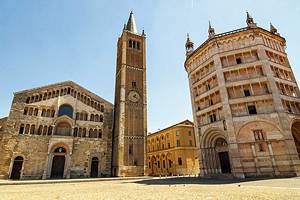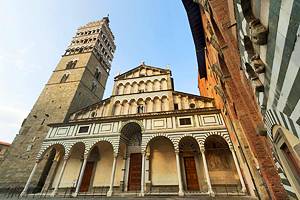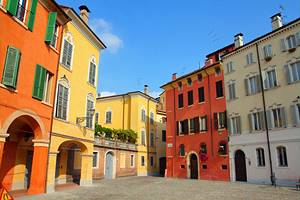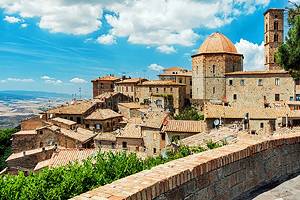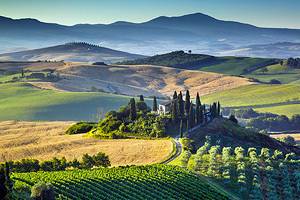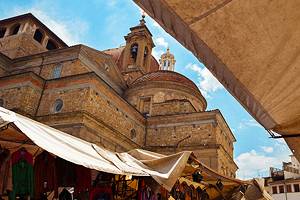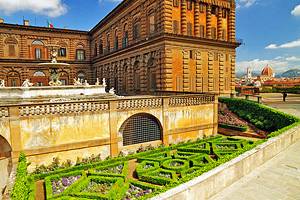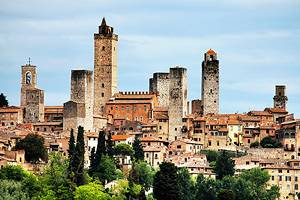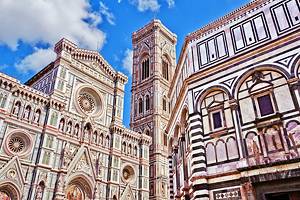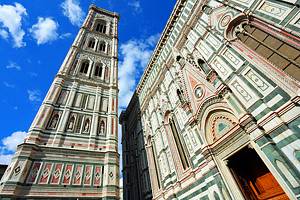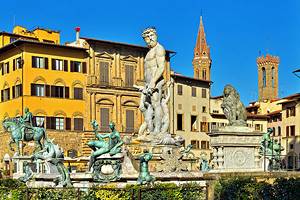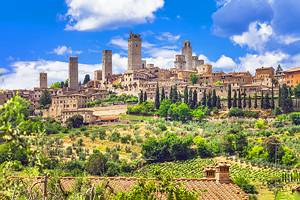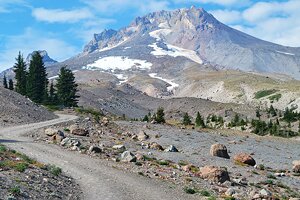Visiting the 5 Towns of the Cinque Terre: The Essential Guide
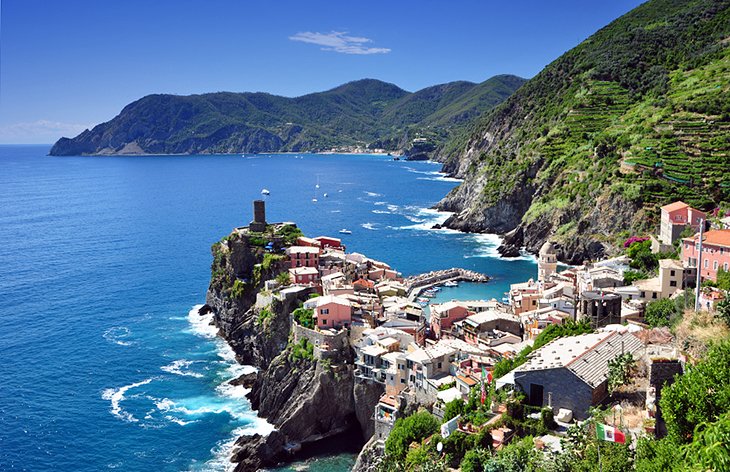
Few places in Italy are as memorable as the Cinque Terre, a land and culture so unique that it has been protected as a national park and designated a UNESCO World Heritage Site. Perhaps what travelers like best is its almost complete lack of traditional must-see sights such as important artworks, churches, palaces, museums, and castles.
Instead, the ambience and natural beauty are the attractions. Popular things to do include walking the breathtaking paths along the cliffs, pausing over gelato in a café surrounded by candy-colored houses, cooling off with a swim, capturing pictures of some of Italy's best views, and just absorbing the Old World charm.
Until the 1960s, these five towns in the cliffs of the Riviera di Levante, between La Spezia and Levanto on the Gulf of La Spezia, were virtually unknown to tourists and difficult to reach, except by boat. Even today, a car is more of a liability than an asset when visiting the five towns of the Cinque Terre and seeing the coast's attractions.
Trains and boats (in good weather) connect the five towns and run frequently. If you have time to see only a few, Vernazza and Riomaggiore are the most photo-worthy and atmospheric and perhaps the best places to visit in the Cinque Terre.
Walking the Cinque Terre
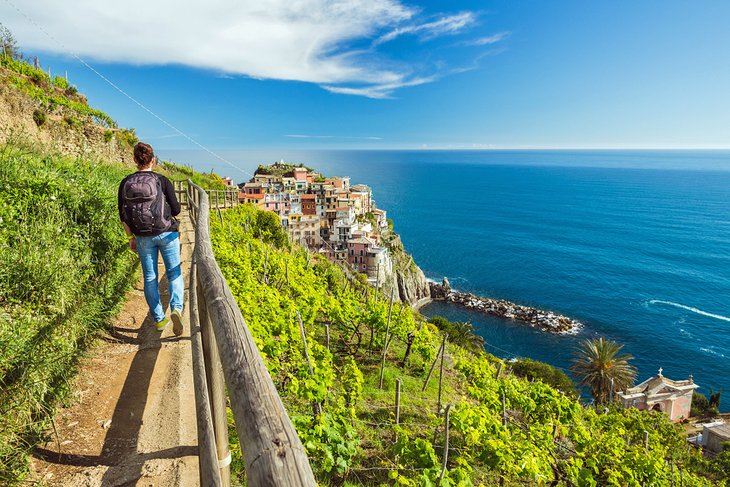
It's often named one of the best hikes in the world. If you possibly can, walk at least one portion of the path carved in the cliffs between the villages. The shortest and widest of these connects Riomaggiore and Manarola, called, in typical Italian fashion, Via dell'Amore (Path of Love). It's also the most crowded, so if you visit in high season and seek more solitude, walk another section. Note that the Via dell'Amore has been closed for repairs, and is expected to reopen in 2023.
Maps are available in park offices (at train stations) where you need to buy an entrance ticket to use the trails. It is also essential to stop there to check the condition of trails and to understand that any or all of them may be closed due to weather or damage.
The prime experience is to hike the entire 12-kilometer Sentiero Azzurro from Monterosso to Riomaggiore, but only for those in good condition with proper boots and no fear of heights. The trail is often very narrow and skirts the face of vertical cliffs with no barriers between hikers and the sea crashing far below.
To walk any section of the trail, you will need to buy at pass. The Cinque Terre Trekking Card gives you access to the paths, while the Cinque Terre Train Card allows you to use the hiking trails with unlimited travel on the Cinque Terre trains. You can buy these at the information desks at every train station in Cinque Terre, Levanto and La Spezia, or online in advance.
1. Monterosso al Mare
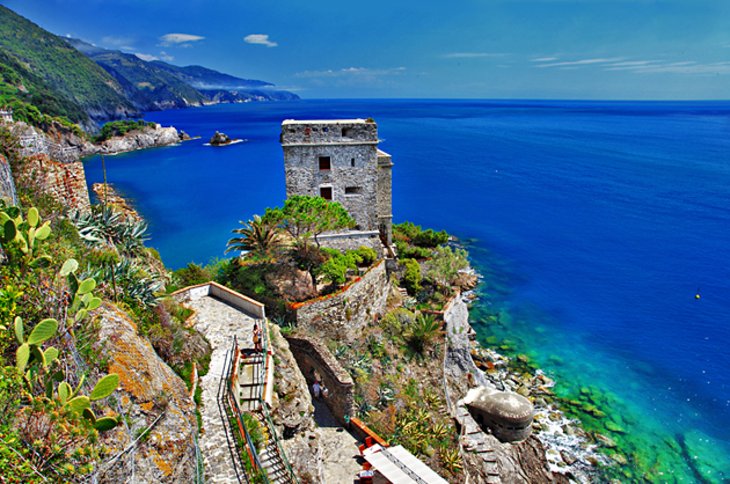
The largest of the five towns is Monterosso al Mare. It is less photogenic but the only one with a sizable beach. In the old part of the town, near the train station, are the 14th-century Loggia del Podestà and the parish church of San Giovanni Battista, whose campanile was built as a Genoese watch-tower.
On a crag above the sea, the medieval Torre Aurora was built to protect the town from frequent pirate attacks. High above, on the road to Vernazza, the pilgrimage church of the Madonna di Soviore has a painted Baroque interior and spectacular views. The sanctuary serves simple meals of local foods to pilgrims and hikers.
High on a promontory overlooking Monterosso Bay, the Convent of the Capuchin Friars is a monastery founded in 1618. Notable artworks include a Crucifixion attributed to Flemish painter Antoon Van Dyck and Saint Girolamo the Penitent by Luca Cambiaso. The setting and the peaceful, contemplative atmosphere make the convent a restful stopping place.
2. Vernazza
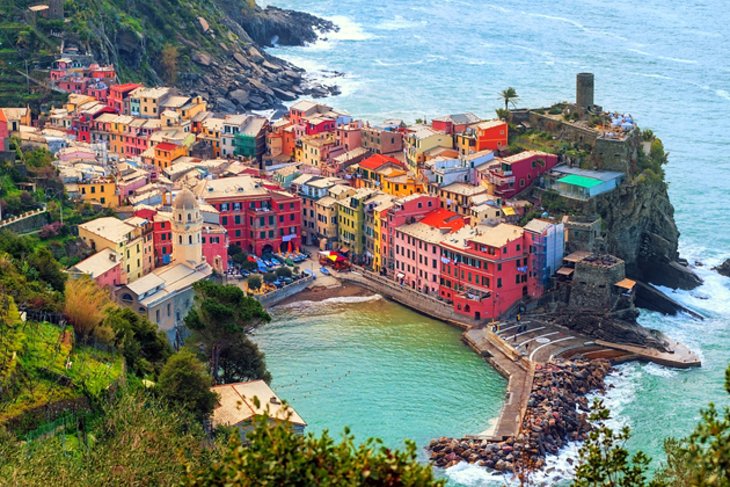
The prettiest of the five villages snuggles in a cleft between rocky cliffs, with colorful houses that seem to be stacked atop each other along its steep, narrow main street. Everything spills into a very pretty little piazza, and below it, little boats bob in the rocky harbor basin when they are not pulled up into the piazza itself.
Scenes don't get much better, nor do places from which to enjoy them. A round tower and a few sections of the old Genoese fortification walls are a reminder of Genoa's war with Pisa in the 1100s.
Even earlier, the town was fortified as a military stronghold to defend the Cinque Terre towns from raids by Saracen pirates. For the best views, climb the steps to the headland opposite the tower and look back.
Each July 20, Vernazza celebrates its patron saint with fireworks and a festival, at the Feast of Santa Margherita.
3. Corniglia
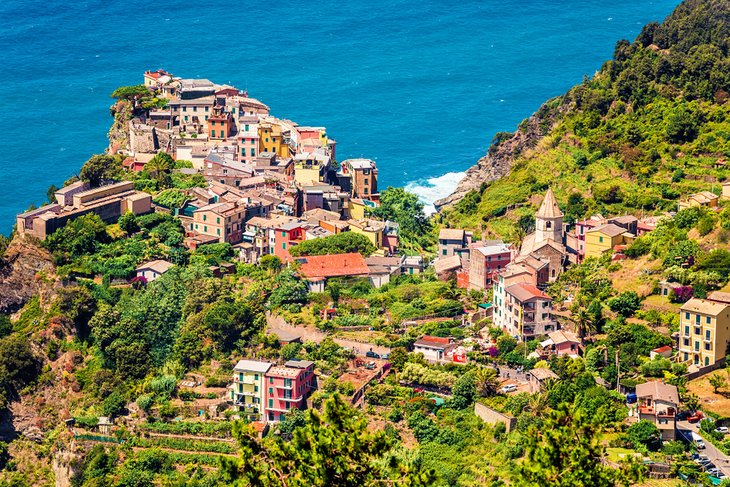
The only one of the Cinque Terre without a harbor, Corniglia stands more than 182 meters above the sea. Also unlike the others, visitors arriving by train must climb up instead of descending into the village.
At the top of the 300-plus steps (which are terraced and not very steep), the church of San Pietro is on the right. It is a good example of the local Gothic style built in the early 1300s, with a painted interior, a 12th-century baptismal font, and a painted altarpiece.
4. Manarola
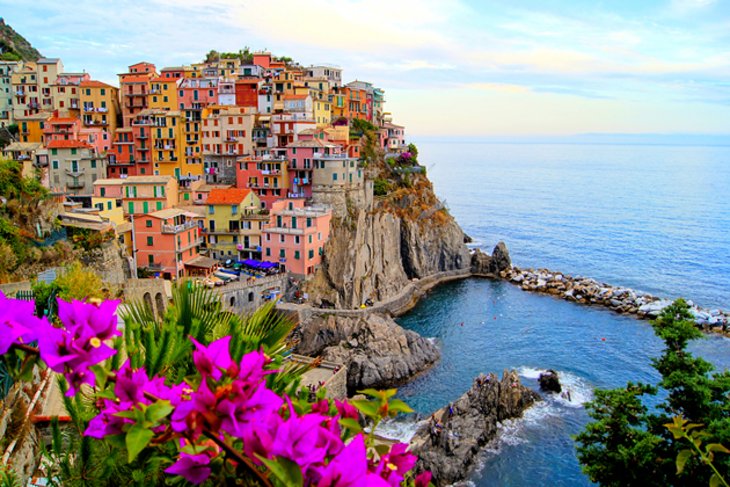
Claim a table in one of the little restaurants in the piazza and savor just-caught seafood with a view over the miniature harbor. Above, the 1338 Gothic church of the Natività di Maria Vergine (also called the church of San Lorenzo) has a beautiful rose window of Carrara marble.
Opposite the church are its freestanding bell tower and a 16th-century watchtower. Although few tourists are here to see it, during December and January, more than 10,000 lamps and 200 figures light the surrounding hillsides in what may be Italy's largest Christmas illumination.
5. Riomaggiore
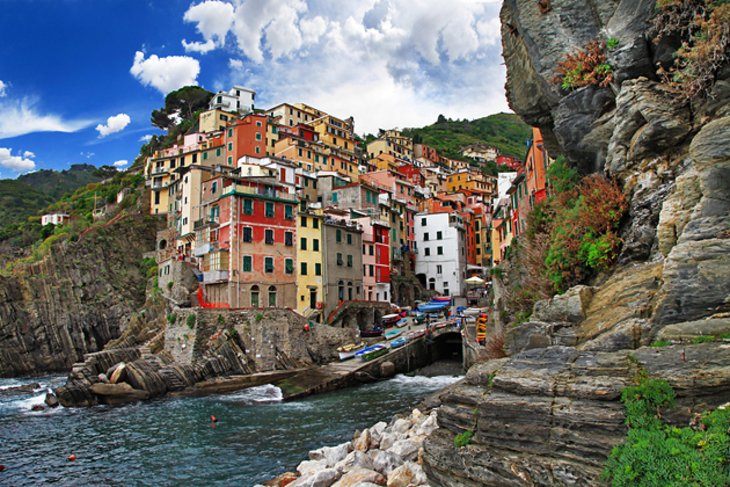
At the eastern end of the Cinque Terre, Riomaggiore is the easiest to reach. The 19th-century Italian artist Telemaco Signorini often stayed here and brought the first attention to the village through his paintings, making it the first of the five to be "discovered" by tourism.
Artists and photographers are still drawn to the village, which is caught in the narrow cleft between two steep headlands. Inside the 14th-century church of San Giovanni look for the carved marble pulpit, painted wooden crucifix, and Renaissance triptych.
Northwest of the village, on Colle di Cerricò, a 10-minute climb brings you to parts of the walls and two round towers, all that remains of a 15th-century castle that was later reinforced by the Genoese. As from nearly any height in the Cinque Terre, the views from the castle are spectacular.
If you are driving here from La Spezia, stop at the Sanctuary of Madonna di Montenero to savor one of the best land-based views encompassing the whole Cinque Terre coast.
Swimming and Boating in the Cinque Terre
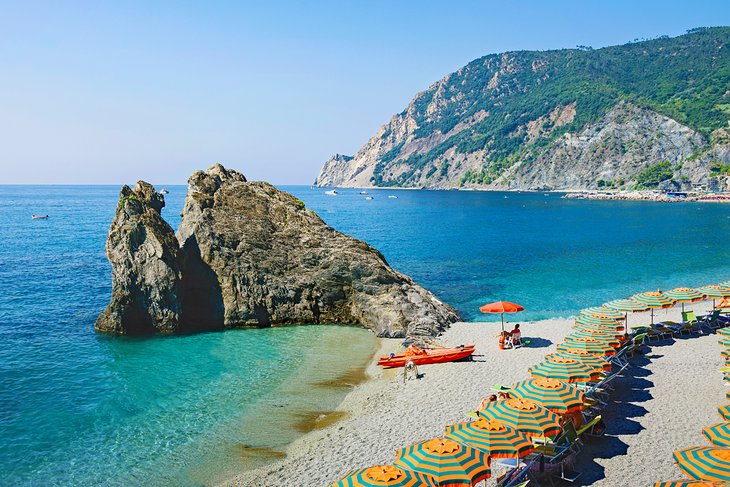
While most tourists concentrate on seeing the villages and walking the trails, the Cinque Terre offers a lot of things to do in the sea. Not known for beaches, it nonetheless has several good places to swim or catch the sun.
While Monterosso al Mare has the only sand beaches, apart from a tiny one at Vernazza, you can join the locals at their favorite spots to sun on the smooth rocks at the old harbors, where you can spread a towel and go for a refreshing swim in the marinas.
Manarola is one of these, especially popular for local youths who delight in jumping off the rocks into the sea, and there's a small rocky beach in Riomaggiore. Remember that these rocks can be very slippery and are no place for flip-flops.
The Ligurian Sea offers more things to do than swim and sun. You can bask in the coast's legendary sunsets on a Cinque Terre Sunset Boat Tour from Monterosso, sailing under the soaring cliffs and photographing these coastal villages from the sea. There's a stop to go ashore in Vernazza.
Or explore the coast under your own power on a Paddle along the Cinque Terre kayak tour with a guide. You can choose from a single or double kayak and learn about the history of this coast from your guide.
How to Make the Most of Your Visit
You can make the trip to the Cinque Terre from Florence by train, but a far more convenient way if you have only a limited time to spend is to join a full-day tour to the Cinque Terre that includes direct transportation by bus or van. Tours feature the best places to visit in the Cinque Terre and are accompanied by a guide who knows the area, its history, and where to find the best views.
- Full-Day Tour to the Cinque Terre from Florence: The best way to maximize your time in the Cinque Terre on a day trip from Florence is to join a tour that includes bus or van travel. The 10-hour Cinque Terre Small Group Day Trip from Florence assures an intimate experience with no more than eight guests in an air-conditioned van, and once there traveling between the towns of Manarola and Vernazza by boat for the best views.
- Full-Day Hiking Tour to the Cinque Terre from Florence: Active travelers can explore these five towns on foot with an experienced guide on a Cinque Terre Hiking Day Trip from Florence, with air-conditioned coach transport to the first town and from the last. Between spectacular hikes, the tour includes a seafood lunch overlooking the sea, a train ride between Vernazza and Monterosso, and a 40-minute boat ride along the Riviera. The total hiking distance is about 5.6 kilometers, and the tour includes the National Park fee.
- Visiting the Cinque Terre on Your Own: The most dependable access is by the local trains, which stop in each village. Even more scenic, but less dependable, is visiting these towns by water from Portovenere, then hopping from town to town by boat. If the sea turns rough, or the boatmen are taking their lunch break, follow the cliff path to the next town or simply climb to the station and move on to the next by train. The only of the five towns you cannot reach by boat is hilltop Corniglia, which has no harbor.




